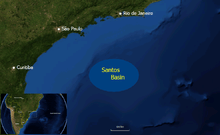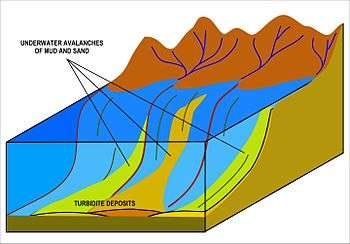Itajaí-Açu Formation
| Itajaí-Açu Formation Stratigraphic range: Cenomanian-Maastrichtian ~100–66 Ma | |
|---|---|
| Type | Geological formation |
| Unit of | Frade Group |
| Underlies | Marambaia Formation |
| Overlies | Itanhaém Formation |
| Thickness | up to 2,000 m (6,600 ft) |
| Lithology | |
| Primary | Shale |
| Other | Sandstone |
| Location | |
| Coordinates | 26°6′S 43°43′W / 26.100°S 43.717°WCoordinates: 26°6′S 43°43′W / 26.100°S 43.717°W |
| Region | Santos Basin, South Atlantic |
| Country |
|
| Type section | |
| Named for | Itajaí-Açu River |
 Location of the Santos Basin | |
The Itajaí-Açu Formation (Portuguese: Formacão Itajaí-Açu) is a geological formation of the Santos Basin offshore of the Brazilian states of Rio de Janeiro, São Paulo, Paraná and Santa Catarina. The predominantly shale with interbedded turbiditic sandstones formation dates to the Late Cretaceous period; Cenomanian-Maastrichtian epochs and has a maximum thickness of 2,000 metres (6,600 ft). The formation is a reservoir rock of the fields in the Santos Basin.
Etymology
The formation is named after the Itajaí-Açu River, Santa Catarina.
Description

The Itajaí-Açu Formation is 1,545 to 2,000 metres (5,069 to 6,562 ft) thick,[1] and comprises a thick interval of dark grey clayey rocks, interbedded with the clastics of the Santos and Juréia Formations. Within this formation, the Ilhabela Member includes the turbiditic sandstones occurring along the section. The sedimentary environment is thought to be marine talus to open basin. Biostratigraphic data from palynomorphs, calcareous nanofossils and planktonic foraminifera indicate a Late Cretaceous age (Cenomanian-Maastrichtian).[2]
Petroleum geology
The formation, mainly its Ilhabela Member, is the main post-salt reservoir rock of the Santos Basin.[3][4] The formation also is the main post-salt source rock and a seal for the post-salt reservoirs.[5]
Fields with Itajaí-Açu reservoirs
| Field | Year | Operator | Reserves (in place) | Notes |
|---|---|---|---|---|
| Panoramix | 2009 | Repsol | 176 MMbbl (28.0×106 m3) | |
| Piracucá | 2009 | Petrobras | 321.4 MMbbl (51.10×106 m3) | |
| Cedro | 2005 | Petrobras | 95.76 MMbbl (15.225×106 m3) | |
| Lagosta | 2003 | El Paso Corp. | 0.173×1012 cu ft (4.9×109 m3) | |
| Uruguá | 2003 | Petrobras | 174.27 MMbbl (27.707×106 m3) 1×1012 cu ft (28×109 m3) | |
| Carapiá | 2002 | Petrobras | 63.52 MMbbl (10.099×106 m3) | |
| Mexilhão | 2001 | Petrobras | 532.23 MMbbl (84.618×106 m3) 3.4×1012 cu ft (96×109 m3) | |
| Tambuatá | 1999 | Petrobras | 212.8 MMbbl (33.83×106 m3) | |
See also
References
Bibliography
- Clemente, Pilar. 2013. Petroleum geology of the Campos and Santos basins, Lower Cretaceous Brazilian sector of the South Atlantic margin, 1–33. Danmarks Tekniske Universitet. Accessed 2017-09-04.
- Contreras, Jorham. 2011. Seismo-stratigraphy and numerical basin modeling of the southern Brazilian continental margin (Campos, Santos, and Pelotas basins) (PhD thesis), 1–171. Ruprecht-Karls-Universität Heidelberg. Accessed 2017-09-04.
- Juarez Feijó, Fávio. 2013. Santos Basin: 40 Years from Shallow to Deep to Ultra-Deep Water. Search and Discovery 10553. 1–49. Accessed 2017-09-04.
- Kiang Chang, Hung; Mario Luis Assine; Fernando Santos Corrêa; Julio Setsuo Tinen; Alexandre Campane Vidal, and Luzia Koike. 2008. Sistemas petrolíferos e modelos de acumulação de hidrocarbonetos na Bacia de Santos. Revista Brasileira de Geociências 38. 29–46. Accessed 2017-09-04.
- Vieira, Juliana. 2007. Brazil Round 9 - Santos Basin, 1–73. ANP. Accessed 2017-09-04.